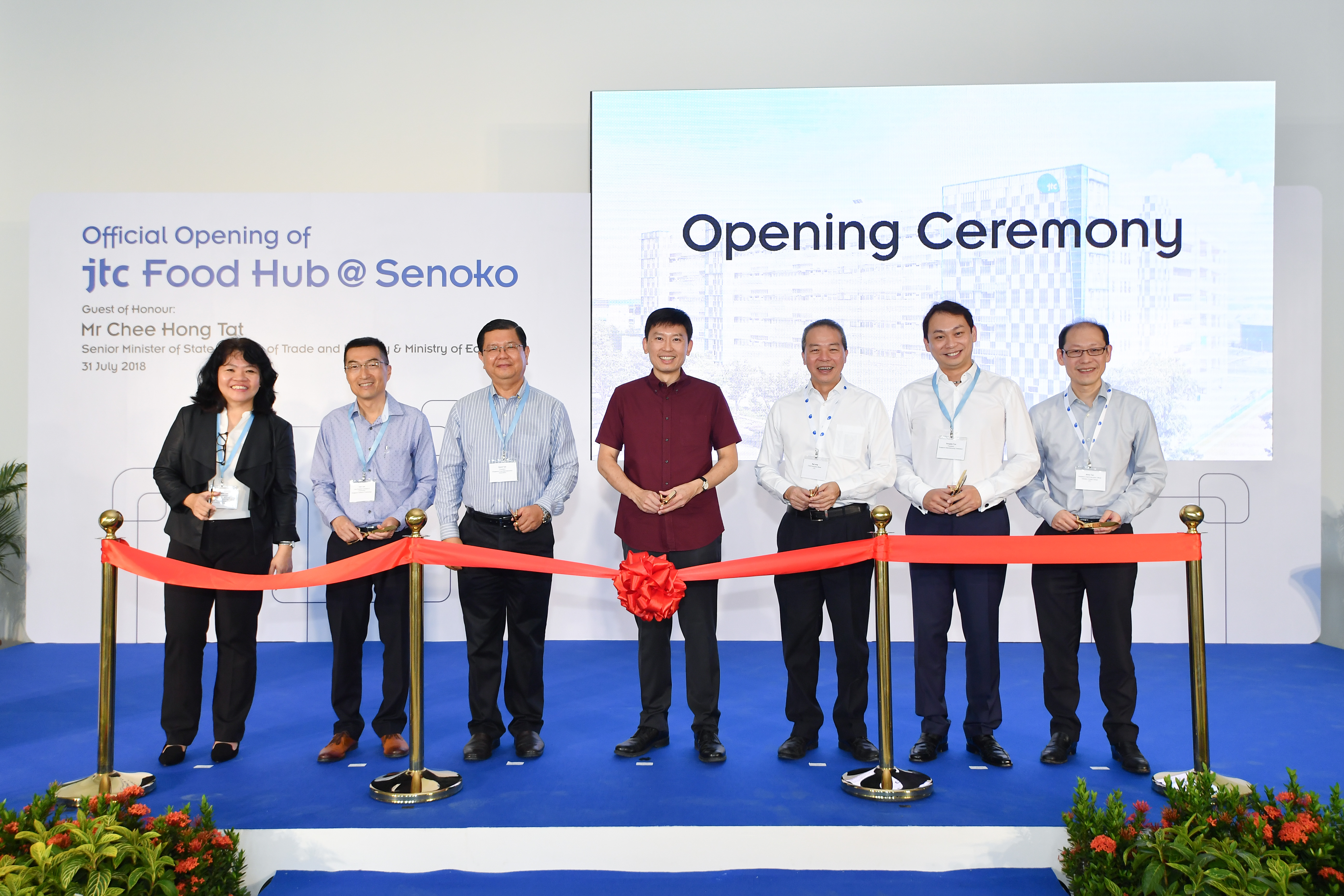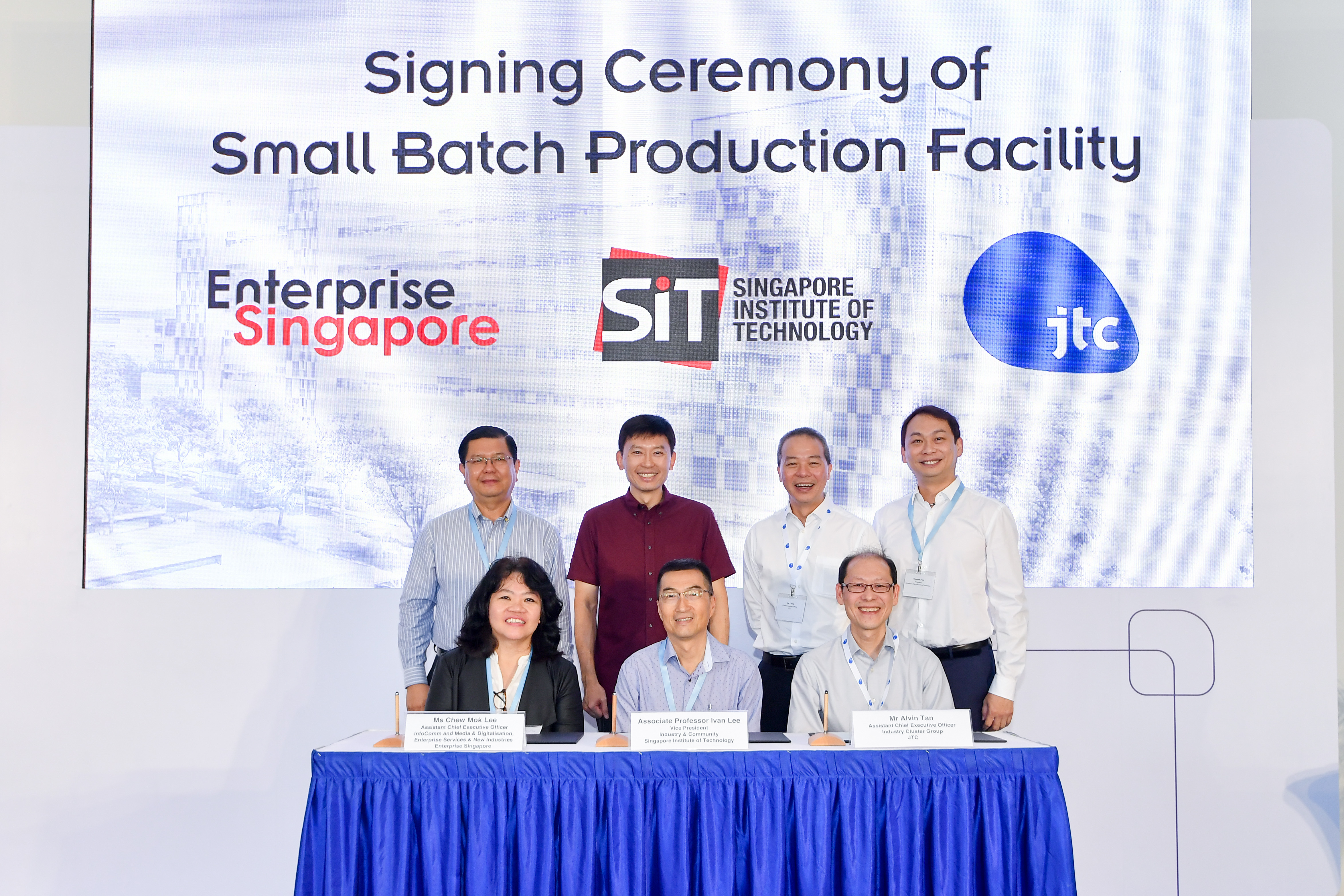Singapore, 31 July 2018 – JTC officially opened its Food Hub @ Senoko, a purpose-built food facility that will be home to an ecosystem of players in the food industry. At the official opening ceremony graced by Senior Minister of State for Trade and Industry, and Education, Mr Chee Hong Tat, a Memorandum of Understanding (MOU) was signed between Enterprise Singapore, JTC and the Singapore Institute of Technology (SIT) to set up a shared facility for small batch production at the Food Hub to support innovation in the industry.

Opening Ceremony of JTC Food Hub @ Senoko
From left to right: Ms Chew Mok Lee, ACEO of Enterprise Singapore; Associate Professor Ivan Lee, Vice President of SIT; Mr David Tan, President of SFMA; SMS Chee Hong Tat; Mr Ng Lang, CEO of JTC; Mr Douglas Foo, President of SMF; Mr Alvin Tan, ACEO of JTC
Jointly conceptualised with the Singapore Food Manufacturers’ Association (SFMA) and Singapore Manufacturing Federation (SMF), JTC Food Hub @ Senoko is designed to help food companies reduce capital and operating costs through shared facilities and services. A key feature is an integrated cold room and warehouse facility (CWF) that tenants can tap on a pay-per-use basis, instead of committing capital and operating expenditure to build and operate their own CWF. The shared CWF is operated by StorBest @ Senoko Pte Ltd, which also offers distribution services that tenants can tap on instead of investing and maintaining their own delivery fleets.
Small Batch Production Facility to Strengthen Food Innovation
Targeted to be operational in end-2019, the shared facility set up by Enterprise Singapore, JTC and SIT is a first in Singapore that aims to fill a gap in the market for small batch production. The facility helps food manufacturers overcome challenges in the development and scalable manufacture of new food products.

Enterprise Singapore-SIT-JTC MOU Signing for Small Batch Food Production Facility
Witnesses (From left to right): Mr David Tan, President of Singapore Food Manufacturers’ Association; SMS Chee Hong Tat; Mr Ng Lang, CEO of JTC; Mr Douglas Foo, President of Singapore Manufacturing Federation
Signatories (From left to right): Ms Chew Mok Lee, ACEO of Enterprise Singapore; Associate Professor Ivan Lee, Vice President of SIT; Mr Alvin Tan, ACEO of JTC
Food manufacturers often face hurdles such as a lack of facilities, costly equipment, high opportunity costs and high minimum order requirements from outsourced manufacturers when commercialising new products after research and development (R&D).
The 1,130 sqm shared facility, to be operated by SIT, will make available production rooms and food processing equipment such as spray dryers1, extruders2 as well as advanced equipment such as Microwave Assisted Thermal Sterilisation (MATS)3 and Pulsed Electric Field (PEF) equipment4 for companies to use on a pay-per-use basis. This will allow food manufacturers, especially start-ups and SMEs, to validate new products after R&D and test their commercial viability before making the leap to full-scale production.
On top of hardware support, there will be workplace training courses, masterclasses and seminars organised at the Food Hub for industry players to deepen technical capabilities and skills. For example, food manufacturing companies can develop capabilities in emerging food technologies through the Food Skills Development Programme (FSDP) supported by SkillsFuture Singapore (SSG) and developed with Enterprise Singapore that aims to create industry solutions through collaboration between industry players and SIT.
SIT’s Vice President (Industry & Community), Associate Professor Ivan Lee said, “As a university of applied learning, SIT actively seeks to build a close nexus with the industry. We work closely with local companies to develop innovative processes and technological solutions to address their business challenges. This facility will serve as a conduit to translate technology know-how into new and better products and processes that can ultimately accelerate the growth of the Singapore food industry and contribute to developing Singapore into Asia’s leading food and nutrition hub.”
Mr David Tan, President of SFMA, said, “The small batch production facility provides a much-needed platform for local food players to trial new products on a smaller scale without having to invest in equipment before bringing them to market. This will greatly support the commercialisation of new products among food players and aid their expansion abroad.”
Mr Douglas Foo, President of SMF, said, “Apart from testing new products, food manufacturers can tap on the shared facility to develop capabilities in food technologies that will help them keep pace with advancing technologies and consumer trends. It encourages the adoption of advanced food processing technologies and automation among food manufacturers that will support the industry’s growth.”
The small batch production facility is an initiative under FoodInnovate, a multi-agency workgroup that looks at catalysing co-innovation and knowledge exchange among stakeholders in the food manufacturing industry.
----------------
1 Spray drying – Technology to convert liquid into dry powder form via rapid drying with hot gas. Supports innovation of powder-form products that are more exportable and cost competitive than liquid products.
2 Extrusion – Technology widely used in the production of pasta, ready-to-eat cereals, snacks, pet food and textured vegetable protein.
3 Microwave assisted thermal sterilisation – Advanced technology that uses microwaves to kill bacteria, extending the shelf life of products for export. It is able to produce shelf stable products, like retort and high pressure processing methods. It opens up opportunities for export to further destinations.
4 Pulsed Electric Field – Advanced non-thermal technology that uses high burst of electrical pulses to inactivate bacteria food, extending the shelf life of products for export. It is suitable for liquid food products that MATS and retort cannot handle.
![[FA] SIT One SITizen Alumni Initiative_Web banner_1244px x 688px.jpg](/sites/default/files/2024-12/%5BFA%5D%20%20SIT%20One%20SITizen%20Alumni%20Initiative_Web%20banner_1244px%20x%20688px.jpg)


